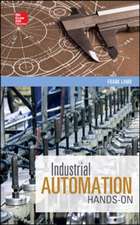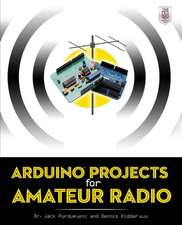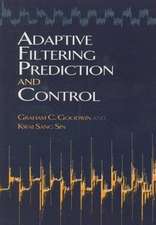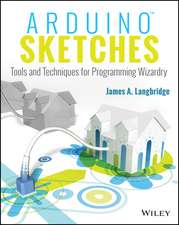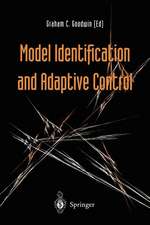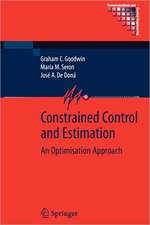Sampling in Digital Signal Processing and Control: Systems & Control: Foundations & Applications
Autor Arie Feuer, Graham Goodwinen Limba Engleză Paperback – 8 oct 2011
Din seria Systems & Control: Foundations & Applications
- 18%
 Preț: 1050.35 lei
Preț: 1050.35 lei - 17%
 Preț: 490.57 lei
Preț: 490.57 lei - 15%
 Preț: 654.95 lei
Preț: 654.95 lei - 15%
 Preț: 654.43 lei
Preț: 654.43 lei - 15%
 Preț: 641.85 lei
Preț: 641.85 lei -
 Preț: 400.10 lei
Preț: 400.10 lei -
 Preț: 394.51 lei
Preț: 394.51 lei - 15%
 Preț: 640.37 lei
Preț: 640.37 lei - 15%
 Preț: 635.80 lei
Preț: 635.80 lei - 15%
 Preț: 646.11 lei
Preț: 646.11 lei - 18%
 Preț: 790.28 lei
Preț: 790.28 lei -
 Preț: 382.36 lei
Preț: 382.36 lei -
 Preț: 386.39 lei
Preț: 386.39 lei - 18%
 Preț: 946.24 lei
Preț: 946.24 lei - 18%
 Preț: 1395.94 lei
Preț: 1395.94 lei - 18%
 Preț: 961.10 lei
Preț: 961.10 lei - 18%
 Preț: 968.19 lei
Preț: 968.19 lei -
 Preț: 388.34 lei
Preț: 388.34 lei - 15%
 Preț: 645.47 lei
Preț: 645.47 lei -
 Preț: 404.13 lei
Preț: 404.13 lei - 18%
 Preț: 965.02 lei
Preț: 965.02 lei - 15%
 Preț: 649.87 lei
Preț: 649.87 lei - 18%
 Preț: 974.98 lei
Preț: 974.98 lei -
 Preț: 386.00 lei
Preț: 386.00 lei -
 Preț: 393.52 lei
Preț: 393.52 lei - 15%
 Preț: 642.68 lei
Preț: 642.68 lei -
 Preț: 390.84 lei
Preț: 390.84 lei -
 Preț: 388.72 lei
Preț: 388.72 lei - 15%
 Preț: 655.45 lei
Preț: 655.45 lei - 20%
 Preț: 1003.63 lei
Preț: 1003.63 lei - 15%
 Preț: 648.89 lei
Preț: 648.89 lei - 15%
 Preț: 645.47 lei
Preț: 645.47 lei -
 Preț: 386.00 lei
Preț: 386.00 lei - 18%
 Preț: 952.89 lei
Preț: 952.89 lei -
 Preț: 396.40 lei
Preț: 396.40 lei - 15%
 Preț: 642.68 lei
Preț: 642.68 lei - 15%
 Preț: 650.19 lei
Preț: 650.19 lei
Preț: 404.51 lei
Nou
Puncte Express: 607
Preț estimativ în valută:
77.41€ • 84.06$ • 65.03£
77.41€ • 84.06$ • 65.03£
Carte tipărită la comandă
Livrare economică 22 aprilie-06 mai
Preluare comenzi: 021 569.72.76
Specificații
ISBN-13: 9781461275466
ISBN-10: 1461275466
Pagini: 580
Ilustrații: XXXII, 544 p.
Dimensiuni: 155 x 235 x 30 mm
Greutate: 0.8 kg
Ediția:Softcover reprint of the original 1st ed. 1996
Editura: Birkhäuser Boston
Colecția Birkhäuser
Seria Systems & Control: Foundations & Applications
Locul publicării:Boston, MA, United States
ISBN-10: 1461275466
Pagini: 580
Ilustrații: XXXII, 544 p.
Dimensiuni: 155 x 235 x 30 mm
Greutate: 0.8 kg
Ediția:Softcover reprint of the original 1st ed. 1996
Editura: Birkhäuser Boston
Colecția Birkhäuser
Seria Systems & Control: Foundations & Applications
Locul publicării:Boston, MA, United States
Public țintă
ResearchCuprins
1 Fourier Analysis.- 1.1 Introduction.- 1.2 The Basic Transforms.- 1.3 Properties of Continuous-Time Fourier Transforms.- 1.4 Properties of Discrete-Time Fourier Transforms.- 1.5 The ? — Impulse Stream.- 1.6 Inter-relating the Various Transforms.- 1.7 Special Topics.- 1.8 Further Reading and Discussion.- 1.9 Problems.- 2 Sampling and Reconstruction.- 2.1 Introduction.- 2.2 Sampled Data Sequences — A Representation of Continuous Signals.- 2.3 Continuous Signal Reconstruction from a Sampled Data Sequence.- 2.4 Shannon’ s Reconstruction Theorem.- 2.5 Practical Methods of Reconstruction.- 2.6 Signal Reconstruction from Periodic Samples.- 2.7 Further Reading and Discussion.- 2.8 Problems.- 3 Analysis of Discrete-Time Systems.- 3.1 Introduction.- 3.2 Shift Operator Models.- 3.3 z-Transforms.- 3.4 The Delta Operator.- 3.5 Difference Equations in Delta Operator Form.- 3.6 Discrete Delta Transform.- 3.7 Use of Discrete Delta Transforms to Solve Difference Equations.- 3.8 The Discrete Transfer Function.- 3.9 Summary of Delta Transform Properties.- 3.10 Stability of Discrete Systems.- 3.11 Discrete Frequency Response.- 3.12 Frequency Domain Stability Criteria for Discrete-Time Systems.- 3.13 Digital Filter Implementation.- 3.14 Further Reading and Discussion.- 3.15 Problems.- 4 Discrete-Time Models of Continuous Deterministic Systems.- 4.1 Introduction.- 4.2 State-Space Development.- 4.3 Transform Development.- 4.4 Continuous-Time and Discrete-Time Poles and Zeros.- 4.5 Numerical Issues.- 4.6 Frequency Domain Development.- 4.7 Further Reading and Discussion.- 4.8 Problems.- 5 Optimal Linear Estimation with Finite Impulse Response Filters.- 5.1 Introduction.- 5.2 Problem Description.- 5.3 Sampled Model.- 5.4 The Discrete Lattice Filter.- 5.5 Continuous-Time LatticeStructure.- 5.6 Relationships between the Discrete and Continuous Lattice Filters.- 5.7 Further Reading and Discussion.- 5.8 Problems.- 6 Optimal Linear Estimation with State-Space Filters.- 6.1 Introduction.- 6.2 Signal Model.- 6.3 The Sampling Process.- 6.4 Discrete Stochastic Model.- 6.5 The Discrete Kalman Filter.- 6.6 Continuous-Time State Estimation.- 6.7 Further Reading and Discussion.- 6.8 Problems.- 7 Periodic and Multirate Filtering.- 7.1 Introduction.- 7.2 Models for Periodic Linear Systems.- 7.3 The Raising Procedure.- 7.4 Frequency Domain Analysis of Periodic Filters.- 7.5 Models for Sampled Periodic Stochastic Systems.- 7.6 Periodic Optimal Filtering.- 7.7 Further Reading and Discussion.- 7.8 Problems.- 8 Discrete-Time Control.- 8.1 Introduction.- 8.2 Closed-Loop Stability and Pole Assignment.- 8.3 Some Special Discrete-Time Control Laws.- 8.4 Sensitivity and Complementary Sensitivity Functions.- 8.5 All Stabilizing Control Laws.- 8.6 State Estimate Feedback.- 8.7 Rapprochement Between State Estimate Feedback and Stabilizing Controllers.- 8.8 Linear Quadratic Optimal Regulator.- 8.9 Duality Relationships.- 8.10 Further Reading and Discussion.- 8.11 Problems.- 9 Sampled Data Control.- 9.1 Introduction.- 9.2 Mixing Continuous and Discrete Transfer Functions.- 9.3 Sensitivity Considerations.- 9.4 Modified Discrete Transforms.- 9.5 Examples.- 9.6 Observations and Comments from the Examples.- 9.7 The Class of All Stabilizing Sampled-Data Controllers.- 9.8 Linear Quadratic Design of Sampled-Data Controllers.- 9.9 Duality Relationships for Hybrid Optimal Controller.- 9.10 Further Reading and Discussion.- 9.11 Problems.- 10 Generalized Sample-Hold Functions.- 10.1 Introduction.- 10.2 Generalized Sample-Hold Function: A Time Domain Perspective.- 10.3 Other Applications of Generalized Sample-Hold Functions.- 10.4 Frequency Domain Analysis of GSHF.- 10.5 Sensitivity Considerations.- 10.6 Further Reading and Discussion.- 10.7 Problems.- 11 Periodic Control of Linear Time-Invariant Systems.- 11.1 Introduction.- 11.2 Periodic Control of Linear Time-Invariant Systems.- 11.3 Time Domain Analysis.- 11.4 Frequency Domain Analysis.- 11.5 Further Reading and Discussion.- 11.6 Problems.- 12 Multirate Control.- 12.1 Introduction.- 12.2 A Unifying Approach.- 12.3 Slow Output Sampling, Fast Input Sampling.- 12.4 Fast Output Sampling, Slow Input Sampling.- 12.5 Further Reading and Discussion.- 12.6 Problems.- 13 Optimal Control of Periodic Systems.- 13.1 Introduction.- 13.2 Control of Linear Periodic Systems.- 13.3 Control based on State Estimate Feedback.- 13.4 Further Reading and Discussion.- 13.5 Problems.

